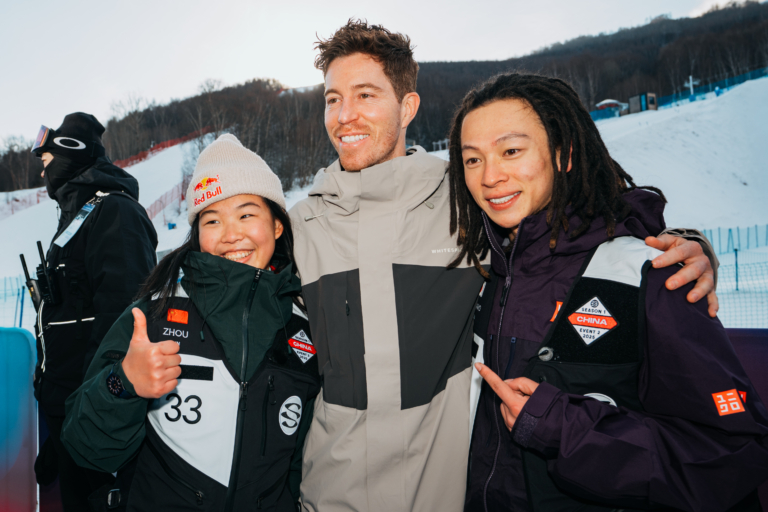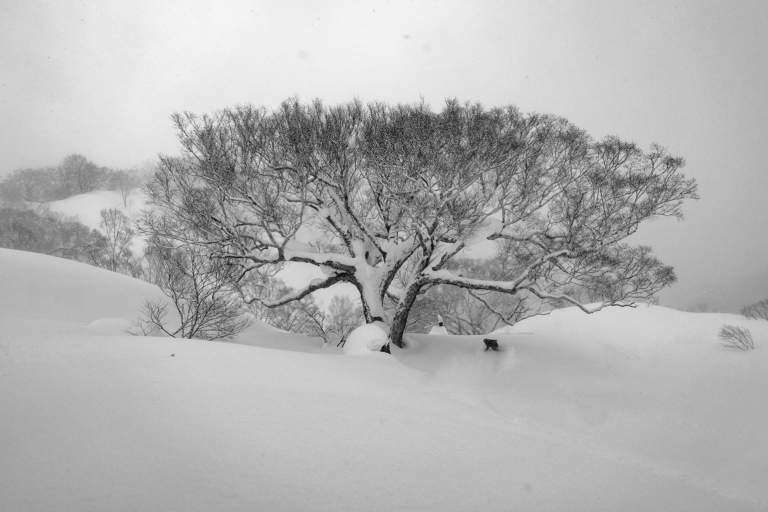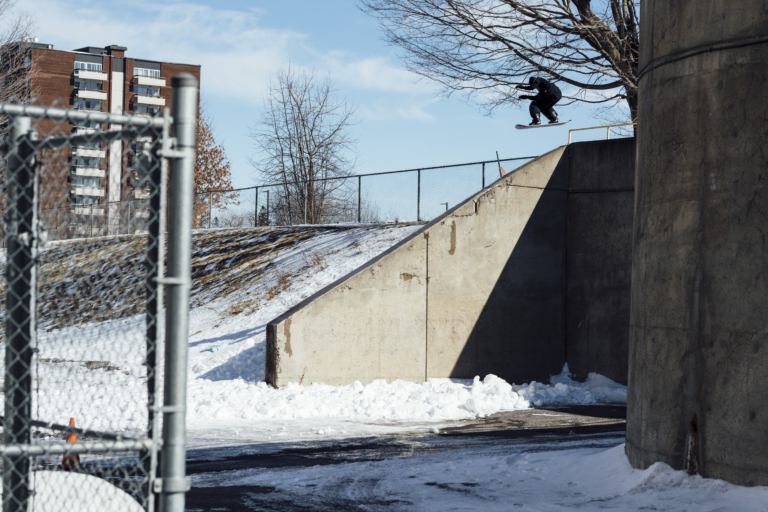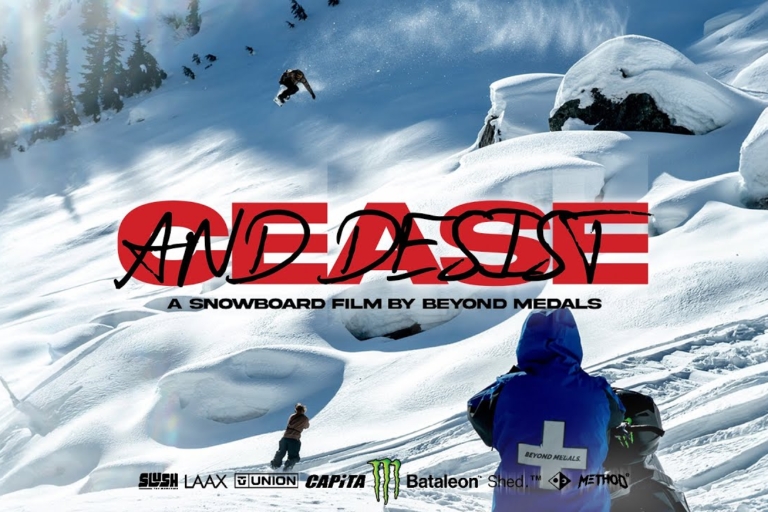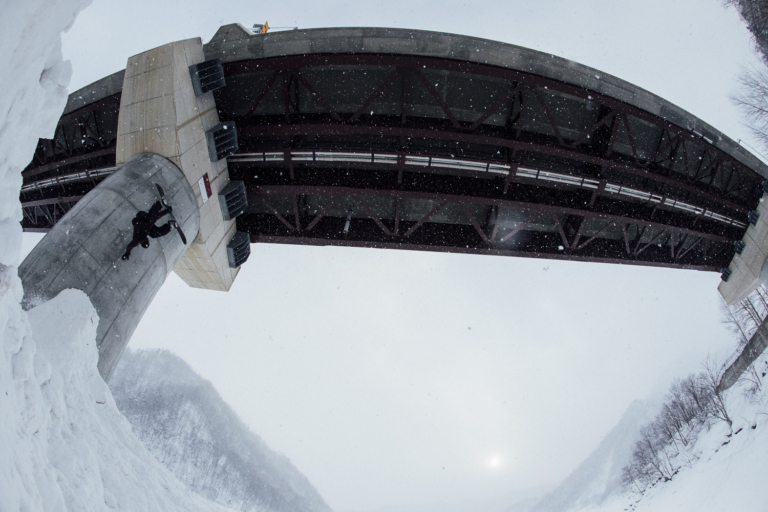A three-day interview with Ralph Kucharek, the 29-year-old rider out of Burlington, Vermont, that has been carving out his own career in the Green Mountains for the better part of the last decade. What exactly is a three-day interview? Well, it was a planned short interview via text that spiraled a bit out of control. Between Ralph’s work, boat repair, cooking, and sleeping, we just kept the thread going and came up with the below. Enjoy Ralph’s take on being a pro on the East Coast, the off-season, the industry, and being on the cusp of turning 30 after some late-season powder turns on Mt. Mansfield. Enjoy. – Mark Clavin
MARK CLAVIN: Yo.
RALPH KUCHAREK: Yo, yo.
Ready for the interview?
Totally works for me. If I’m a bit delayed it’s because I am scraping a really bad sealant job out of a boat I got last fall. Moral of the story is don’t half-ass it the first time.
What kind of boat we talking?
Oh, we are not just talking about just any boat. It is a 16-foot Duroboat that I found on Facebook Marketplace last fall for an absolute steal of a price. I could not resist and now own two boats, so I think I’ve made it. It’s for fishing and relaxing, definitely some guiding, as well, once it is seaworthy.
Seaworthy? What sea you taking it on in Burlington?
Believe it or not, Lake Champlain was once part of the Atlantic Ocean. Now it just flows through the St. Lawrence Seaway. It’s definitely a lake, but I like to imagine it’s the ocean.

Do you guide in the off-season for fishing?
Yeah, I do. My company is called The Vermont Fly Fishing Company aka @vtflyco. At the moment I am guiding part-time, but I definitely want to see how far I can take it and hopefully it will be full time soon.
What’s the equivalent to a perfect powder day while fishing?
Going to a place you’ve never been and catching a ton of big fish. Two weeks ago I was in Western New York with a friend and over a three-day period we landed thirty Great Lakes steelhead. That was definitely like a powder cycle.
Who are your sponsors right now?
Rome, Bonfire, Coal, Purl Wax, and Bolton Valley.
You are born and raised Vermont, yeah?
Yeah, I was born in Burlington and have been here ever since.
How was it in the hotbed of Vermont growing up? Has it changed since?
You know the whole thing about how experiences and time build perspective? Looking back at growing up in Vermont, this place was definitely a hotbed for snowboarding. When I was 6 or 7, I started riding in 1997 at Bolton Valley. I only knew of the Burton Snowboarding Company and Terje at that point in time. I had no idea what the older kids were up to. At that exact time, Seth Neary was setting the standard for style and tricks, Original Sin was here and Sully [Dan Sullivan] was just getting started and eventually transitioned to the start of Rome Snowboards, Yale Cousino and Chris Rotax were teenagers and progressing riding ahead of their time, Jake Blauvelt was cutting his teeth at Bolton and Stowe, Kyle Clancy and Colin Langlois were probably sending it to the moon, Travis Kennedy might’ve been riding at Stowe, Bud Keene was coaching the next generation, Johnny Noel was finding the best tree rides in VT, the US Open was popping like the roaring twenties, the Glebelands were in full force, and so much more was going on and all before I even hit puberty. I got to meet a lot of these riders and learned the history from Pat Bridges and talking with Shem Roose. Those two being down to talk and share their experiences have been really impactful for me, especially when I was in my early twenties and really aspiring to try and make something happen being in Vermont. Over time I saw the hey-day of snowboarding fizzle out as the recession hit and things did start to cool down. Losing the US Open was a really big straw-break for the camels back. I understand why it moved and it had to for a lot of reasons, but that event had an immense impact on the scene here and I am really thankful we had access to it. Anyone could show up to spectate and the riding spoke for itself, especially with the conditions being so variable. Anyway, things have recalibrated since then.
Right now, the state of our community here and the amount of enthusiasm I’ve witnessed for riding hasn’t just sustained, it’s definitely growing again. This year was a great example. Blauvelt’s Banks, the Sidesurfers Banked Slalom, Rome’s Side Hit Seance, all the events Woodward at Killington has put on, the East Street Archives book party–these are events that bring a lot of us together and if we can keep it up I think the future is looking bright.
How long have you been (or considered yourself) a pro snowboarder?
I started getting a good amount of support from Bonfire about six years ago and would probably consider that when I could start calling myself a pro. In all honesty though, I’ve never quite felt like a professional snowboarder as far as industry labels go, but the amount of time, dedication, and love I’ve put into snowboarding… I consider to be on the professional level. If I could make my own category though, I think I would just fall under snowboarder. Regardless of status, I’ve gotten everything and more I could’ve ever dreamed out of snowboarding.
In this day and age, what do you consider a pro snowboarder?
I consider a pro snowboarder a rider who, year-after-year, is out there riding a lot, filming, getting photos, competing, and trying to have an impact on the sport or their community. I also think there are riders who really stick out from the pack, whether their style and approach is really good or they’ve got raw talent and are going faster and bigger than everyone. It gets tricky though–there are riders who are not paid at a professional level, but perform at one. I like to think it’s how others perceive your riding. There can be industry validation and status, too.
https://vimeo.com/359438659
Why did you never make the jump out West?
I was able to spend a lot of time out there and travel a bunch out of here, too. Spent a lot of time sleeping on floors and couches and can’t thank those who let me stay with them enough. Those were amazing times. I think it was a blend of life events, which made it a lot harder to move away from home, choosing to go to college here in Vermont, and at this point, really enjoying the snowboard community here and how the East Coast does snowboarding in general. I definitely want to do a lot more time out West but I’m definitely happy with where I’m at. I’m a pretty open book though and would like to do a winter or year out West sooner than later. Didn’t you move back to Ohio?
I did.
We will have to swap lake-view pictures.
(Many lake photos later…)
Aside from guiding in the off-season, do you work on the side in the winter, as well?
I’ve been able to take the winters off and then in off-season I’ve been guiding and doing a lot of odd jobs. Last summer, I got a taste of what being a carpenter feels like–mostly a lot of landscaping and garden maintenance–but when I was younger and saving up for winters, I was trash man and janitor one year for the Burlington Park system. It was pretty eye-opening how little respect people treat public restrooms with. It’s amazing how disgusting they can get. One time I arrived to a trashcan that was stuffed with a deer carcass. We all know it, but cleaning it is a whole different story.
What did you study in college?
I studied community and international development, and concentrated in sustainability.
So with that degree, aren’t you are also technically a scientist?
Yes, ha. I always wanted to be a marine biologist (classic 90s kid dream) but wasn’t cut out for biology and still became a scientist. It’s remarkable how things work out sometimes.
Are you hoping to apply that specifically to snowboarding in any way?
Yeah, that was the intention when I first started and I’d still like to. I’m still just working on the “how” part, but all the progress we are making toward inclusivity, affordability, and building community gives me a lot of hope.
As a pro rider, do you think if you are supported by a company, they should be a bit on the hook for injury insurance if you are hurt while trying to create content for them? Even an am rider, if they get hurt filming a part, should the company help out with medical expenses? I know it isn’t that simple, but…
I really hope we can get to that point as an industry. Did you know medical debt is the largest cause of bankruptcy in America? It’s really tough to say if companies should be obligated to help, but it would definitely help riders, especially if they’re hurt while filming for that brand or project. I blew my knee out riding when I was 25 and was thankfully still on my parents health insurance. Shouts to Obama. I had the golden plan for our insurance company and still had to pay about $4,000 out of pocket between co-pays, braces, physical therapy, and a grand for my surgery that my insurance didn’t cover. My injury was due to bad judgement on my part, but it happened and thankfully my sponsors continued to support me and give me time to heal up, which in the long run was very helpful.
There’s a few ways to cut it, but a good solution could be a blend of brand commitment to riders, whether it’s putting them on company health insurance with the rest of the employees or brands being patient with riders who are injured and trying to continue on as a paid snowboarder. Ideally, we would all have health insurance, but outside of snowboarding it’s really expensive for everyone. I think the best case would be universal health care in the US, then we would all win. Another really relevant benefit of health insurance is access to mental health services which is a big conversation right now.
We can switch to some happier topics. Any thoughts on that recent storm? When was the last time you had a late-April pow run?
We had a really good powder day on May 12th the spring the pandemic started. It made no sense and that surprise storm was the juice all our crews’ morals needed!
Turns out this April provided the best base depths of the year though, and the top half of most of our mountains here, especially Stowe and Jay Peak, have been getting a lot of late-spring, elevation-dependent snowfall. There has been a noticeable difference on the top half of the mountain, which made the late storm even that much better. The trails got a solid snow event the week before, melted smooth to corn snow, and then we got another 3-9 inches of dense snow on top. This is the one time of the year the trails with a good base on them still are completely flat. It allowed for some really smooth, fast riding, which is rare in these parts.
In terms of our seasons, I’ve definitely noticed they’re changing a lot. There seems to be more inconsistent snowfall and more variability in snowpack from snow, rain, and cooling cycles. We had a record year a few years ago when we filmed 100 North and this past season was below-average snowfall all year, and from what I understand, for much of the country. In general, I’m concerned about what the future might hold. To pull things together, these past storms were a good example of what future storms could look like.
 Ralph and Timmy Sullivan hiking during Snowboy Productions x Rome Snowboards Side Hit Seance at Sugarbush in March. p: Pat Ryan
Ralph and Timmy Sullivan hiking during Snowboy Productions x Rome Snowboards Side Hit Seance at Sugarbush in March. p: Pat Ryan
What are the biggest pro and cons of riding on the East coast?
Pros: variability keeps it interesting, wicked rippahs, lots of heart, deep-rooted snowboarding history.
Cons: variability driving you nuts; walk far, ride less; Stowe charging for parking; 3,068 miles to Glacier, Washington.
Walk far, ride less? I thought you loved splitboarding?
I’m more of a boot pack the skin track or Verts type of guy, actually. Big plot twist, the whole crew goes old school. But man are those splitboards efficient. The Rome Uprise Split rides super well, which is good. I get out there during the season.
Which board are you using?
The Rome Uprise Split, which is a good, trusty, well-shaped all-mountain vehicle. It’s on the very affordable side, especially relative to a lot of other split options. But I got a sticker on my splitboard that says my preferred board is not this one. And then it points to a hardboard, ha.
Would your biggest piece of advice for splitboarding be “get Verts and ride the lift?”
Hahaha, in general yes, but they truly do have an application. I think it’s like sometimes not every tool works for the job, but sometimes specific jobs need specific tools. If things are Vert-friendly, I’d prefer to do that. I mean if it were like full-on zombie apocalypse pandemic or if resorts didn’t open and things were how they were going, I probably would’ve done anything to make sure I got to the mountain on a powder day and splitboarded a lot more.
What board do you like to hike with on your back then and why?
Rome Ravine Select. It’s a really good board. It’s fast, has a small amount of taper so it turns really well, the flex is pretty stiff and it supports my tall frame, and it’s just one of those boards you don’t have to think about riding. It does it all, from park to powder, and I prefer to ride the same board as long as possible.
What would you say to someone that wants to go pro and stay on the East Coast? Any advice besides “Do what Zeb Powell is doing,” ha.
Wow, I almost said that and also serious shout out to Zeb. What an incredible snowboarder and Vermont is lucky to have him in the books here. But I would say to someone who wants to go pro and stay on the East Coast that you can do it. I think the key is focusing on what your strengths are and trying to differentiate yourself from the rest, style- or approach-specifically. I also think, don’t be afraid to travel and sync up with people out West because it builds community and will push your riding a lot. Lastly, I’d say find your crew and put in the work, it’s a long-game sometimes and persistence is key, especially if you live here.
What differentiates you from other riders out there?
Probably trying to be a “pow” rider on the East Coast, which hasn’t always been the case, so I’m not sure if that counts as a differentiation.
You work on any projects this year?
I took a trip out to Washington with Tomas Ruprecht, Craig Brown, and Nathanael Asaro and we ended up getting some really sick photos for Nathanael’s book, but our winter here was too variable, so nothing project-wise popped up. However, I helped dig for Blauvelt’s banked slalom and John Murphy’s Sidesurfers Banked Slalom. And the Rome team spent a week here, which was an insanely good time.
How is it having many of your Rome teammates euro-based?
I have to say, I wish they were much closer. It was such a pleasure hanging out with Len [Jorgensen] and Ståle [Sandbech]. I hope there is some more cross-pollination of riding together in the future with them and the rest of the team.
What are you stoked on in snowboarding right now?
I’d really just like to take a moment to thank everyone who has been there for me on my snowboarding journey. My crew, my close friends and family, my girlfriend, my sponsors, everyone involved with 100 North, and to all the people who have let me crash on their couch, gave me rides to the mountain, took time to board together, got me into an event, or welcomed me into the crew whether here or elsewhere. Also shout out to Mike Yoshida and Matt Stillman for all the support. There are a few crews, people, and things I am really hyped on coming up here. Mason Lemery is on the come up and has arrived. The Spotheads have come up and I am really psyched on how hard they work to make it happen. They’ve got a really good vibe, like OG-snowboarding-punk-rock-ride-and-do-what-you-want type of vibe. Maggie Leon is also on the come up and deserves every bit of recognition she has gotten this season and prior.
What are you bummed on in snowboarding right now?
Snowboarding has gotten so expensive. It has always been pricey and thankfully there are non-profits focused on getting riders out there and inspiring them to continue snowboarding as long as they can. The unfortunate truth is $100-plus lift tickets, high gas prices, lodging, and the cost of one day of riding is unaffordable for a lot of people. I think if we want a really diverse, inclusive snowboarding community we need more riders from all economic backgrounds and demographics. Snowboarding is a point of connection for people and the less diverse it is, the more we become a monoculture of affluent people doing the same thing over and over. I’ve always admired skate culture because of its diversity and interesting people that skate; that’s possible because it’s extremely accessible and affordable relative to snowboarding.
And how often the word “community” is used in snowboarding, especially from the industry and core. I think it’s important to be really careful about what community you’re talking about and there’s a big difference between communities and cliques. When I think of the word community, I group all snowboarders as a whole and then consider different regions or snowboarding hot spots micro-communities. A lot of “community” events are exclusive, especially when they’re invite-only, the same goes for crews, too. This suits the core community, but not the whole. I’d like to see, as a whole, when riders, brands, and events refer to community that it means the viewers, locals, families, and supporters outside of our core groups. I have been guilty of this in the past, but I think we could all benefit by clarifying which community we are referring to.
Last one, what does pro snowboarding look like for you going forward?
I actually really struggle with the “how to keep being able to do this thing.” The price of gas, tickets, passes, and everything has gone up to a point where unless budgets get larger to increase purchasing power for the same amount of things, I can’t do as much. At the end of the day, being a paid rider is earned, but also a really lucky thing to get paid to do, especially because it’s just snowboarding. It isn’t easy work by any means, but it’s a beautiful thing when there is a “job” out there that is go snowboarding and travel with your friends. It’s a lifestyle I want to keep living, but as I get closer to 30 years old, I have a lot of bills to pay.
Lately, these realities have really set in for me and they’ve really forced me to look ahead at how snowboarding will be in my life and how to interact with it going forward. The process has been like mourning a death, but what I have been mourning is the fact my body is more sore and my knee isn’t as good as it used to be, time and money and motivation is putting limitations on those 100 day seasons I used to have, and how in order for myself to build the life I want, there is potential snowboarding will receive less time. That perspective has given me a lot of hope with snowboarding and how it works for us naturally changing over time. I’ve always thought there are chapters in our riding and it makes sense why a lot of older riders transition to powder or out of the industry. There are physical and monetary limitations and I think that is also okay, because there is a lot to life outside of snowboarding.
I go snowboarding because I love it and nothing more at this point. The biggest payout this whole thing has to offer is continuing to love it and doing it on your own accord.

